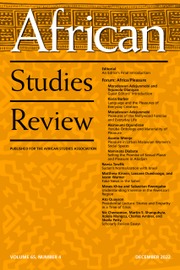Article contents
Perpetuating Underdevelopment in Kenya: The Link between Agriculture, Class, and State
Published online by Cambridge University Press: 23 May 2014
Extract
The Republic of Kenya is a land of stark contrasts. Its precapitalist policies have long attracted multinational investment and international loans. External capital is apparent to Western tourists in the capital city of Nairobi, an urban area with luxurious hotels, modern corporate and government offices, expensive automobiles, large sports stadiums, and numerous stores. But the modern features of Nairobi do not represent the real Kenya, the Kenya known to the vast majority of those in the country. The average Kenyan is not wealthy and does not possess Western-style amenities. Most Kenyans work in agriculture-related activities which range from subsistence farming to wage labor on large estates or plantations. In fact, recent statistics show that the agricultural sector employs over 81 percent of the labor force, contributes 65 percent to the value of total exports, and accounts for 31 percent of the Gross Domestic Product (GDP) (World Bank, 1986a).
In addition to an appreciable disparity in income between urban elites and agricultural laborers, there is also an uneven distribution of resources within the agricultural sector. The present structure of agriculture is closely linked to the colonial period, when Europeans controlled large-scale farms in areas with fertile land. Although few Europeans farm in Kenya today, the agricultural system is still inequitable and biased toward Africans with large farms. Inequality is evident in the distribution of farm land, the flow of capital in and out of agriculture, and the class structure that perpetuates this situation. The Kenyan state remains closely aligned with elite interests in both rural and urban areas, thereby maintaining an unproductive agricultural system that contributes to underdevelopment.
Information
- Type
- Articles
- Information
- Copyright
- Copyright © African Studies Association 1990
References
- 15
- Cited by

